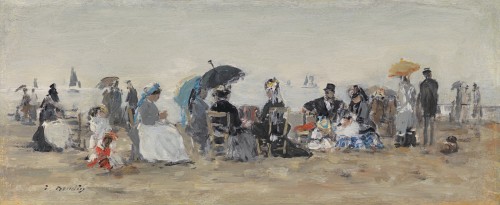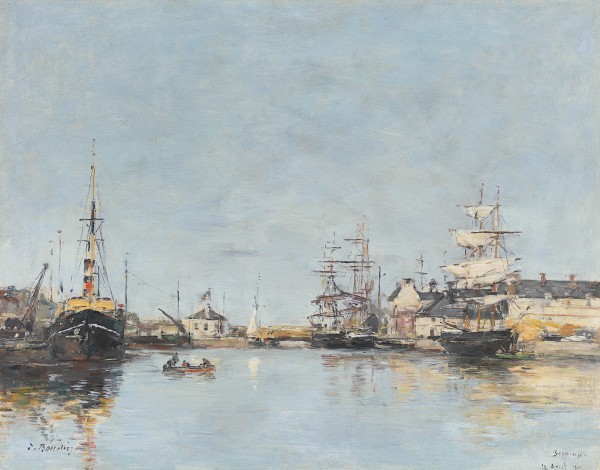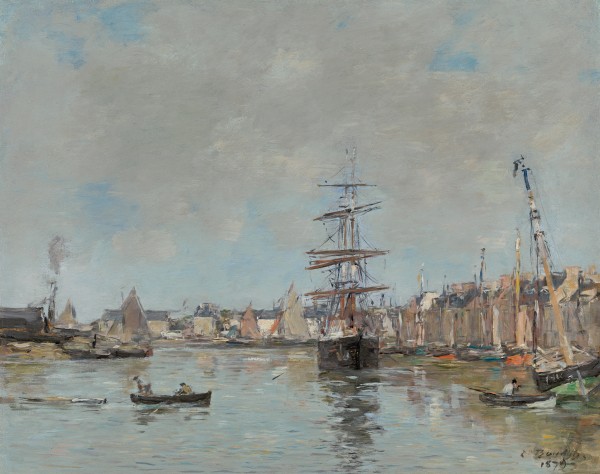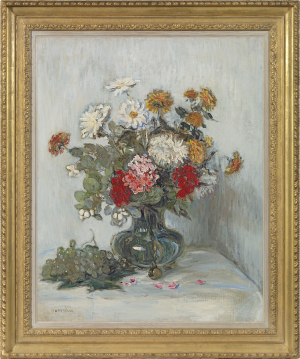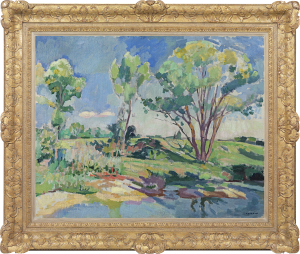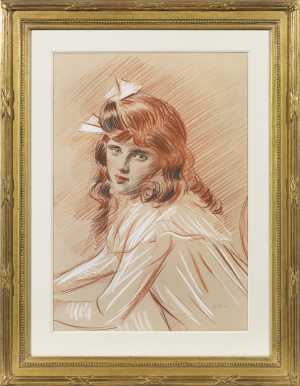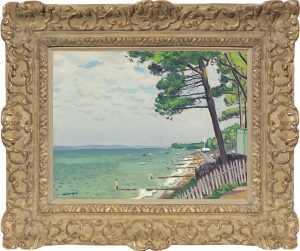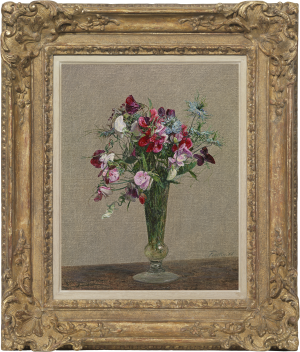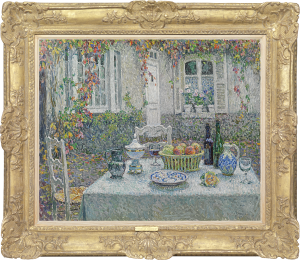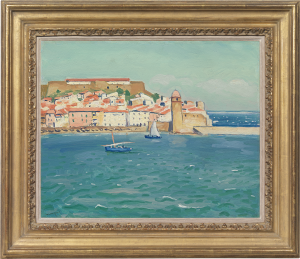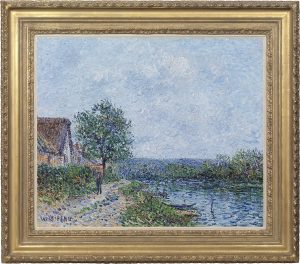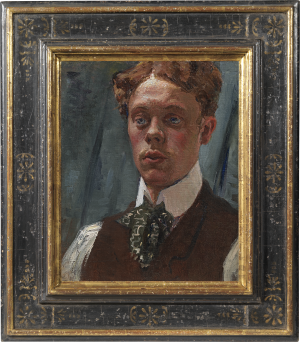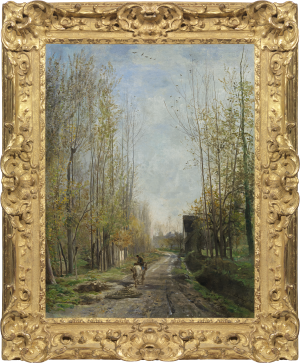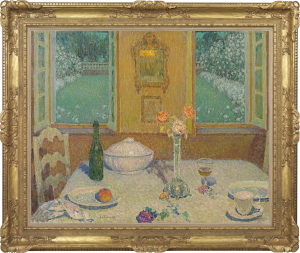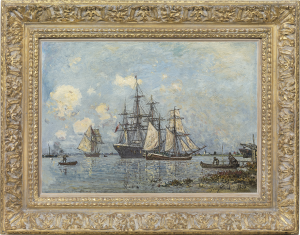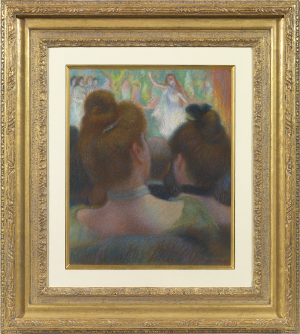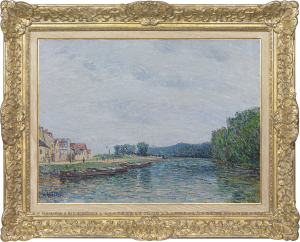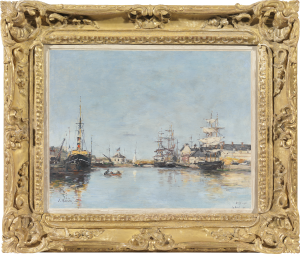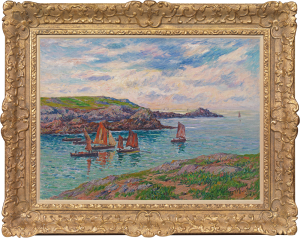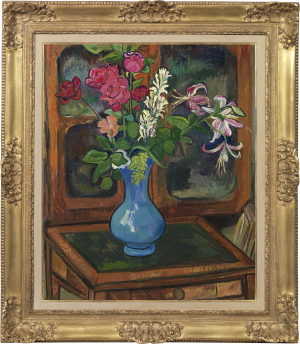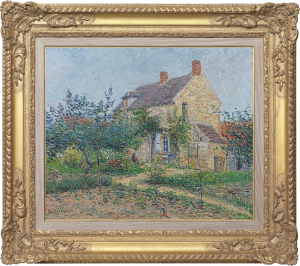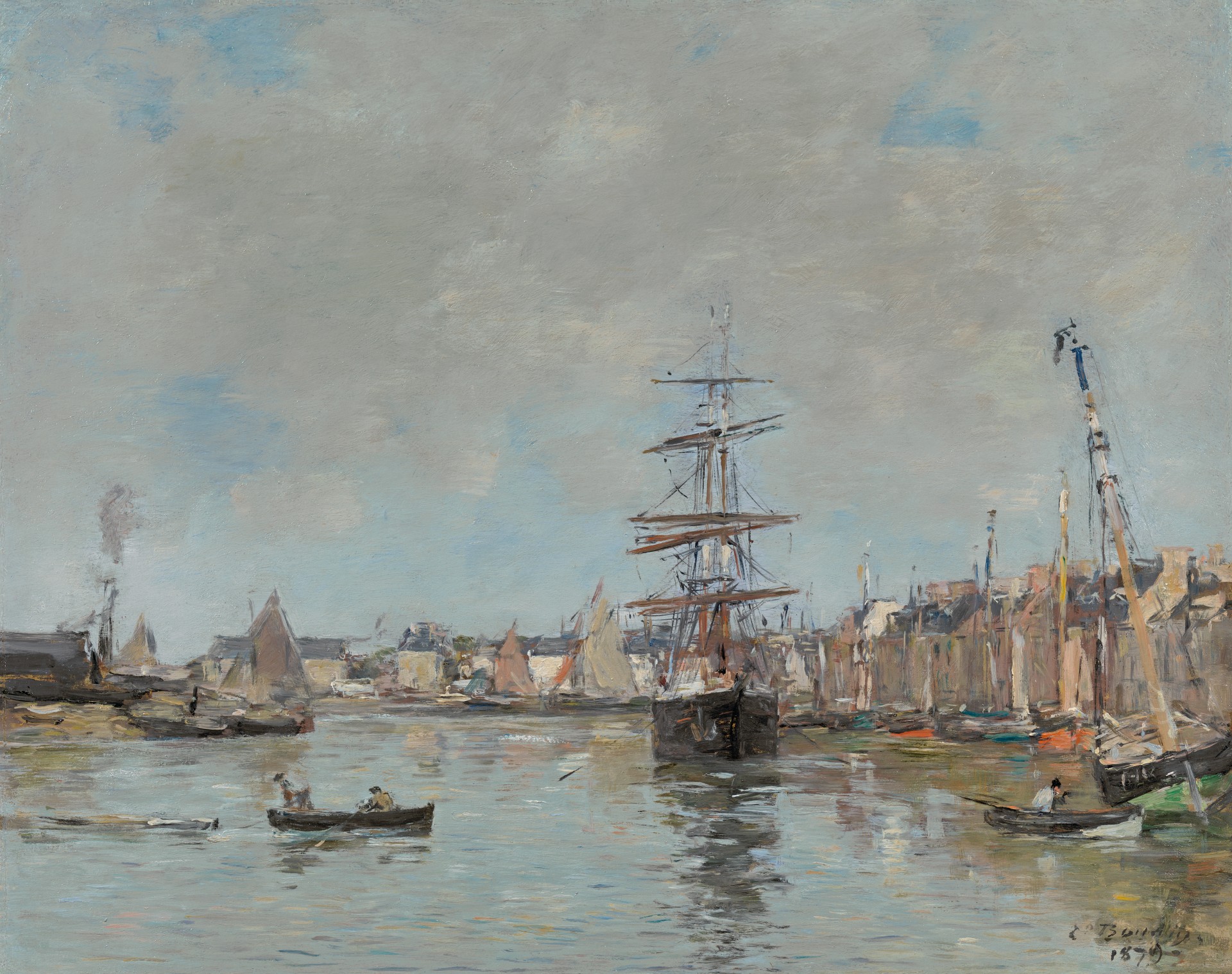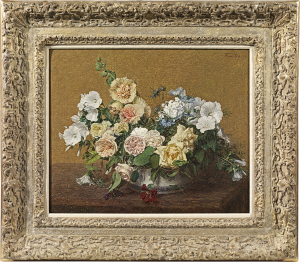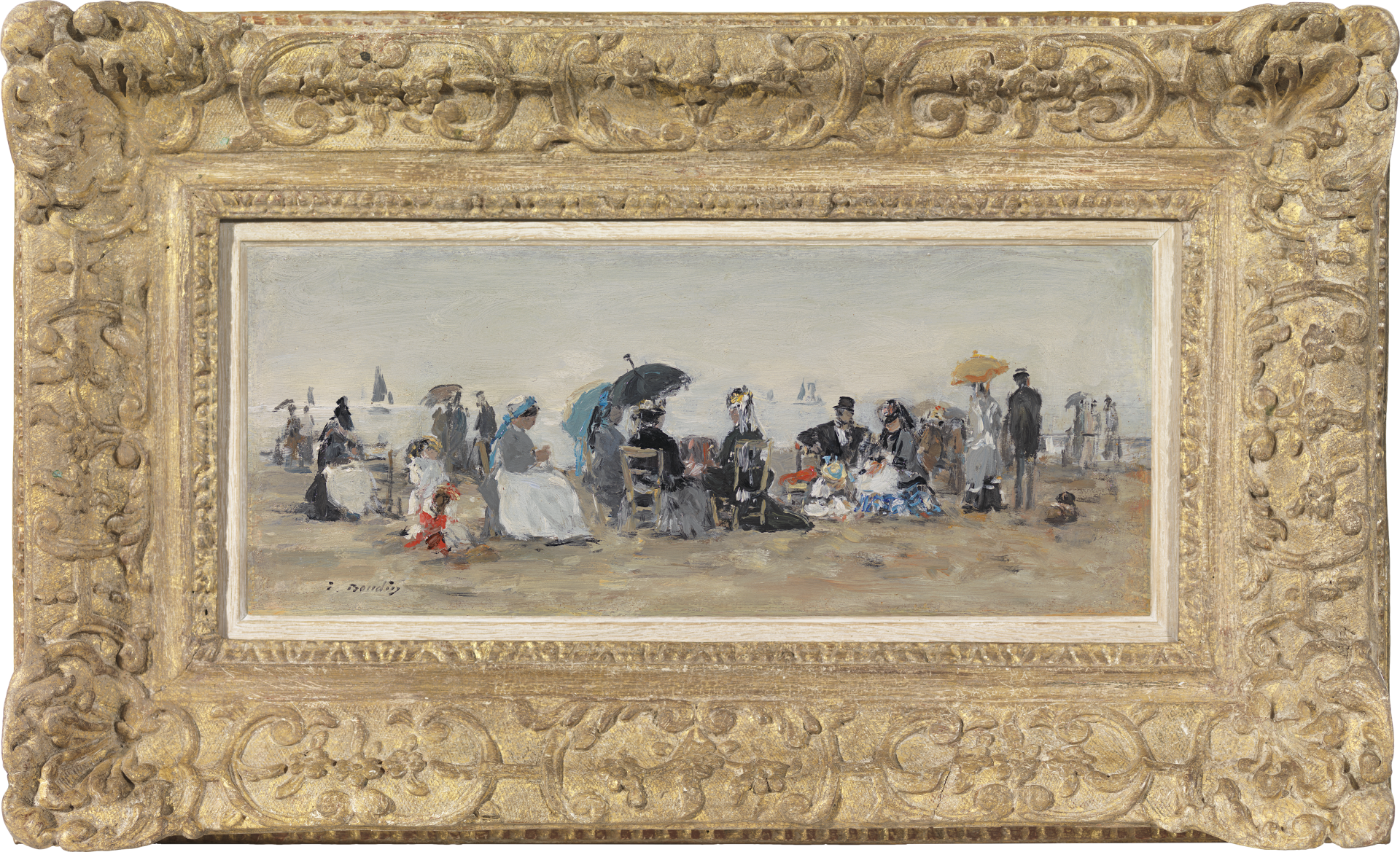Eugene Boudin
Trouville, scène de plage
Oil on panel: 5.5 x 14 (in) / 14 x 35.6 (cm)
Signed lower left: E. Boudin
This artwork is for sale.
Please contact us on: +44 (0)20 7493 3939.
Email us
EUGENE BOUDIN
Honfleur 1824 - 1898 Deauville
Ref: BT 147
Trouville, scène de plage
Signed lower left: E. Boudin
Oil on panel: 5½ x 14 in / 14 x 35.6 cm
Frame Size: 13 x 21¼ in / 33 x 54 cm
Painted circa 1870-74
Provenance:
Antoine Vollon, Paris
Watelin Collection, Paris
Diéterle Collection, Paris
Arthur Tooth & Sons, London, inv. no.5934
Lady Baillie (1899-1974), Leeds Castle, Kent;
her estate sale, Sotheby’s London, 4th December 1974, lot 5
Schröder and Leisewitz, Bremen;
from whom acquired in the 1970s by Barbara Lambrecht, Siegen, Germany
Exhibited:
Bremen, Kunsthalle, Eugène Boudin, September-November 1979, no.23
Literature:
Robert Schmit, Eugène Boudin 1824-1898: Catalogue Raisonné de l’Oeuvre Peint, Paris 1973, vol. I, p.223, no.612, illus.
Eugène Boudin painted beach scenes in the Normandy resort of Trouville from the early 1860s to the 1890s, and can be said to have invented the genre of depictions of the fashionable bourgeoisie enjoying the sea air. This painting is a superb example of Boudin’s beach scenes from the 1870s, when an impressionistic deftness and freedom of brushwork replaced the more deliberately modelled compositions of the previous decade. Boudin was interested in the relationship of figures, sand, sea and sky, refracted in the dazzling coastal light. The sense of airiness and space in this small painting is palpable. Boudin controls the frieze-like composition of the figures by means of subtly interlocking hues of black, white, blue, yellow and touches of red, moving the eye across the canvas in an almost filmic panorama.
Boudin knew Charles Baudelaire and his theories about the painting of ‘Modern Life’, the cool gaze of the artist on the urban scene. Baudelaire declared: ‘I detest the countryside, especially in fine weather….When I bathe, it’s in my bath-tub’[1]. In choosing the thoroughly contemporary phenomenon of the beach scene, where all the artificialities of Paris met untrammelled Normandy nature, Boudin was also staking a claim to be a ‘Painter of Modern Life’, as he half-humorously admitted in a letter of 1868 to his friend Ferdinand Martin. ‘[I have been congratulated] for daring to include the things and people of our own time in my pictures, for having found a way of making acceptable men in overcoats and women in waterproofs….But don’t these bourgeois, who stroll on the jetty towards the sunset, have the right to be fixed on canvas, to be brought to the light’[2].
Boudin painted en plein air until the end of his life, although he also finished paintings in his studio. He considered that ‘direct paintings’ which kept the vitality of first sight were ‘done on the spot or based on a very recent impression’[3]. Small oil on panel paintings, like the present work, would have been easy to handle out of doors, though most of the oil paintings that Boudin intended for sale would have been finished in the tranquillity of the studio.
In the 1850s, Boudin fired the young Monet, a fellow Norman, with the importance of painting en plein air, and was much revered by the group of artists who became known (at first contemptuously) as the Impressionists. As a result, Boudin was invited to participate in the first Impressionist exhibition in 1874.
EUGENE BOUDIN
Honfleur 1824 - 1898 Deauville
Eugène Boudin was one of the most important precursors of the Impressionists, with his emphasis on working directly from nature and free, naturalistic brushwork. His ‘Crinolines’, depicting fashionable holidaymakers enjoying the beaches of northern France, ushered in a new genre, but he was also renowned for coastal and harbour scenes.
Born in Honfleur, Boudin was the son of a harbour pilot and bred to the sea, working as a cabin boy for his father. After a brief period of schooling, in 1835, he worked with a stationer and framer who displayed the work of artists, then set up his own stationery and framing business in 1844. Boudin’s clients included Thomas Couture, Eugène Isabey, Jean-François Millet and Constant Troyon, all of whom had an influence on his efforts to draw and paint. In 1847 Boudin went to Paris to copy Old Masters in the Louvre; he was particularly impressed by the seventeenth century Dutch school and by the Barbizon painters. In 1851 he was awarded a three-year painting scholarship by the city of Le Havre. He drew his subjects from the Normandy and Brittany coasts. In 1858 he met the young Claude Monet, who had grown up in Le Havre, and stressed to him the importance of making oil paintings directly from nature to capture the constantly changing beauties of the landscape.
Boudin made his debut at the Salon in 1859, where his work was admired by Charles Baudelaire. He befriended Courbet, Daubigny and Corot, who heralded him as ‘the king of the skies’. Paris-based in the winter, Boudin spent his summers on painting tours around the coast of Le Havre, Honfleur and Trouville, inspired by the elegant society that flocked to the burgeoning seaside towns and by the busy maritime traffic. At Trouville in 1862 he met Johan Barthold Jongkind and, influenced by his boldness of technique, adopted freer brushwork and a brighter palette. The following year he married Marie-Anne Guédès.
Boudin made several journeys to Belgium and The Netherlands, initially to shelter from the Franco-Prussian War (1870-71). From 1892 to 1895 he visited Venice, making subtle, atmospheric and highly individual views. He also painted in the south of France, where he stayed in the 1890s for the health benefits of the mild winter climate. Boudin exhibited at the Salon from 1863 to 1897 and participated in the First Impressionist Exhibition in 1874.
From the 1870s Boudin enjoyed increasing financial security. In the 1880s he was taken up by the influential art dealer Paul Durand-Ruel, who organized exhibitions of his pictures in 1883, 1889, 1890 and 1891. In 1892 Boudin was awarded the Légion d'Honneur. He died in Deauville in 1898.
Works by Eugène Boudin can be found in the many museums worldwide including The National Gallery of Art, Washington DC; The Metropolitan Museum of Art, New York; The National Gallery, London; Musée d’Orsay, Paris; Musée du Louvre, Paris and The Hermitage, St Petersburg.
[1] Quoted in Vivien Hamilton, Boudin at Trouville, London 1992, p.19.
[2] Quoted in Hamilton, op. cit., p.20.
[3] Quoted in ibid., p.151.

